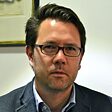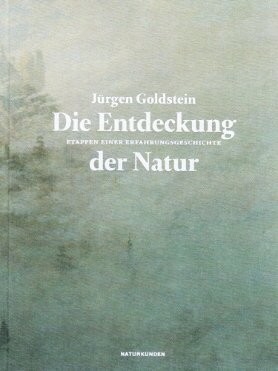Jürgen Goldstein
Die Entdeckung der Natur. Etappen einer Erfahrungsgeschichte
[The discovery of nature]
- Matthes & Seitz Verlag
- Berlin 2013
- ISBN 978-3-88221-992-0
- 310 Pages
- Publisher’s contact details
Jürgen Goldstein
Die Entdeckung der Natur. Etappen einer Erfahrungsgeschichte
[The discovery of nature]
This book was showcased during the special focus on Russian (2012 - 2014).
Sample translations
Review
When the great ethnologist Claude Lévi-Strauss experienced the strange nature of Brazilian rain forests on a research expedition in the 1930s, it resulted in consternation and bewilderment, the repercussions of which were still felt decades later. The journey that led him 3,000 kilometers inland sent him into a kind of mental state of excitement: "I felt as if I were reliving the adventures of the first explorers of the 16th century. I was discovering the New World for myself. Everything seemed enchanted to me: the landscapes, the animals, the plants."
These voyages to mostly unknown, remote areas of the world have now been collected in The Discovery of Nature (published in 2013) by Jürgen Goldstein, a professor of philosophy at the University of Koblenz-Landau. Such expeditions were also always encounters with the marginal regions of the human, the wholly Other, the stranger. For man, Goldstein writes in his introduction, is the creature who sees far around himself and who is constantly expanding his field of vision. He is an animal with borderline symptoms, who has become an observational nomad by virtue of the earth’s immense wealth. Crossing boundaries and overcoming obstacles is a part of man’s nature: “To leave one’s ancestral coast behind and travel the seas is an expression of the will to follow the promise of the unadorned horizon.”
The reports on these voyages of discovery on land and water are narrated in this book, as its subtitle suggests, as "stages of a history of experience.” They are considered an expression of shifting conceptions of nature. The founding document of this gateway to the world, the perception of the naturalness of nature, is traced by Goldstein to the transition from the Middle Ages to modernity, more precisely to Petrarch's ascent of Mont Ventoux in 1336. Yet even Petrarch was already part of a literary tradition. That is, his view is guided by the books he has read, and his notes would in turn guide future explorers. Whoever enters a strange world or seeks a new sea route--a path through unending ice or to the top of a mountain--is often already familiar with reports by other adventurers or travelers and is able to be tempted by descriptions of exotic plants or fabulous treasures. At that point, he often ends up seeing what he had already imagined in his head.
The wide-ranging perspective of this book--part of the series Naturkunden launched by Judith Schalansky for the publishing house of Matthes & Seitz--is revealed in the variety of the sixteen chapters in nearly 300 pages of text. Christopher Columbus’s outstanding achievement was not the discovery of the New World but the courage to leave the old one. When in 1492 he surrendered himself to the sea and wind and reached America, the landscape of the unknown continent turned into his real adventure. Yet he was only able to describe it using examples of the trees, shrubs and flowers familiar to him. For Maria Sibylla Merian, who traveled in 1699 from Amsterdam to Surinam, the study of nature was an act of piety. To her mind, even insects—despised as well at her time—were part of God's plan inasmuch as they allowed nature to be recognized as a realm of unique regularity, splendor, and abundance.
For his part, Goethe, who ascended the Brocken in 1777, found in the rugged landscape of the Harz Mountains a welcome counterpart to his courtly world. It also provided him with a means of overcoming his own inner turmoil elicited by the death of his sister. His successful journey to the summit in the midst of winter was a sign from the gods which confirmed his special status. The entomologist Jean-Henri Fabre, who ascended Mont Ventoux in 1865, was (unlike Petrarch) less interested in the panorama than the details. What mattered to him was the peak’s flora and fauna. The mountain was merely a pile of gravel that made possible his observation of rare specimens, a veritable "feast for the eyes."
By contrast, when Fridtjof Nansen reached the 86th parallel in 1895, after his ship had been frozen solid for months, he found himself exposed in a completely deserted world. Amid the hardened ice, the barking of his dogs appeared to breach a centuries-old stillness. In this realm of nature, man no longer had a place. In an equally hostile environment, Reinhold Messner had to assert himself in 1980 when scaling Mount Everest unaccompanied. This ultimate adventure rendered the landscape a scene for something different. Here, the climbing was performed for its own sake: "If what is seemingly impossible becomes reality, an exciting process of consciousness ensues. And the most intense expression of this tension can be found in extreme mountaineering. When one climbs higher, the experience of the self reaches its greatest intensity. Everything is in flow. Neither the summit nor the pathway there, but survival instead becomes the meaning of it.”
Out of such extreme experiences, reality is worked upon such that the internal nature of man is measured by the external, having to assert itself there. That is how the terminus of experiencing nature is reached. As observed by Goldstein in the conclusion of his book, the age of the expeditions of discovery, of exploring the unknown, is now a thing of the past, compared with today’s virtually seamless measurement and recording of the world. Fortunately, by means of Goldstein’s narrative of the call of distant shores, readers can once again undertake a grand expedition.

These voyages to mostly unknown, remote areas of the world have now been collected in The Discovery of Nature (published in 2013) by Jürgen Goldstein, a professor of philosophy at the University of Koblenz-Landau. Such expeditions were also always encounters with the marginal regions of the human, the wholly Other, the stranger. For man, Goldstein writes in his introduction, is the creature who sees far around himself and who is constantly expanding his field of vision. He is an animal with borderline symptoms, who has become an observational nomad by virtue of the earth’s immense wealth. Crossing boundaries and overcoming obstacles is a part of man’s nature: “To leave one’s ancestral coast behind and travel the seas is an expression of the will to follow the promise of the unadorned horizon.”
The reports on these voyages of discovery on land and water are narrated in this book, as its subtitle suggests, as "stages of a history of experience.” They are considered an expression of shifting conceptions of nature. The founding document of this gateway to the world, the perception of the naturalness of nature, is traced by Goldstein to the transition from the Middle Ages to modernity, more precisely to Petrarch's ascent of Mont Ventoux in 1336. Yet even Petrarch was already part of a literary tradition. That is, his view is guided by the books he has read, and his notes would in turn guide future explorers. Whoever enters a strange world or seeks a new sea route--a path through unending ice or to the top of a mountain--is often already familiar with reports by other adventurers or travelers and is able to be tempted by descriptions of exotic plants or fabulous treasures. At that point, he often ends up seeing what he had already imagined in his head.
The wide-ranging perspective of this book--part of the series Naturkunden launched by Judith Schalansky for the publishing house of Matthes & Seitz--is revealed in the variety of the sixteen chapters in nearly 300 pages of text. Christopher Columbus’s outstanding achievement was not the discovery of the New World but the courage to leave the old one. When in 1492 he surrendered himself to the sea and wind and reached America, the landscape of the unknown continent turned into his real adventure. Yet he was only able to describe it using examples of the trees, shrubs and flowers familiar to him. For Maria Sibylla Merian, who traveled in 1699 from Amsterdam to Surinam, the study of nature was an act of piety. To her mind, even insects—despised as well at her time—were part of God's plan inasmuch as they allowed nature to be recognized as a realm of unique regularity, splendor, and abundance.
For his part, Goethe, who ascended the Brocken in 1777, found in the rugged landscape of the Harz Mountains a welcome counterpart to his courtly world. It also provided him with a means of overcoming his own inner turmoil elicited by the death of his sister. His successful journey to the summit in the midst of winter was a sign from the gods which confirmed his special status. The entomologist Jean-Henri Fabre, who ascended Mont Ventoux in 1865, was (unlike Petrarch) less interested in the panorama than the details. What mattered to him was the peak’s flora and fauna. The mountain was merely a pile of gravel that made possible his observation of rare specimens, a veritable "feast for the eyes."
By contrast, when Fridtjof Nansen reached the 86th parallel in 1895, after his ship had been frozen solid for months, he found himself exposed in a completely deserted world. Amid the hardened ice, the barking of his dogs appeared to breach a centuries-old stillness. In this realm of nature, man no longer had a place. In an equally hostile environment, Reinhold Messner had to assert himself in 1980 when scaling Mount Everest unaccompanied. This ultimate adventure rendered the landscape a scene for something different. Here, the climbing was performed for its own sake: "If what is seemingly impossible becomes reality, an exciting process of consciousness ensues. And the most intense expression of this tension can be found in extreme mountaineering. When one climbs higher, the experience of the self reaches its greatest intensity. Everything is in flow. Neither the summit nor the pathway there, but survival instead becomes the meaning of it.”
Out of such extreme experiences, reality is worked upon such that the internal nature of man is measured by the external, having to assert itself there. That is how the terminus of experiencing nature is reached. As observed by Goldstein in the conclusion of his book, the age of the expeditions of discovery, of exploring the unknown, is now a thing of the past, compared with today’s virtually seamless measurement and recording of the world. Fortunately, by means of Goldstein’s narrative of the call of distant shores, readers can once again undertake a grand expedition.
Translated by David A. Brenner

By Matthias Weichelt
Matthias Weichelt is Editor-in-Chief of the journal Sinn und Form. He writes for a number of publications including the "Frankfurter Allgemeine Zeitung" and the "Neue Zürcher Zeitung".
